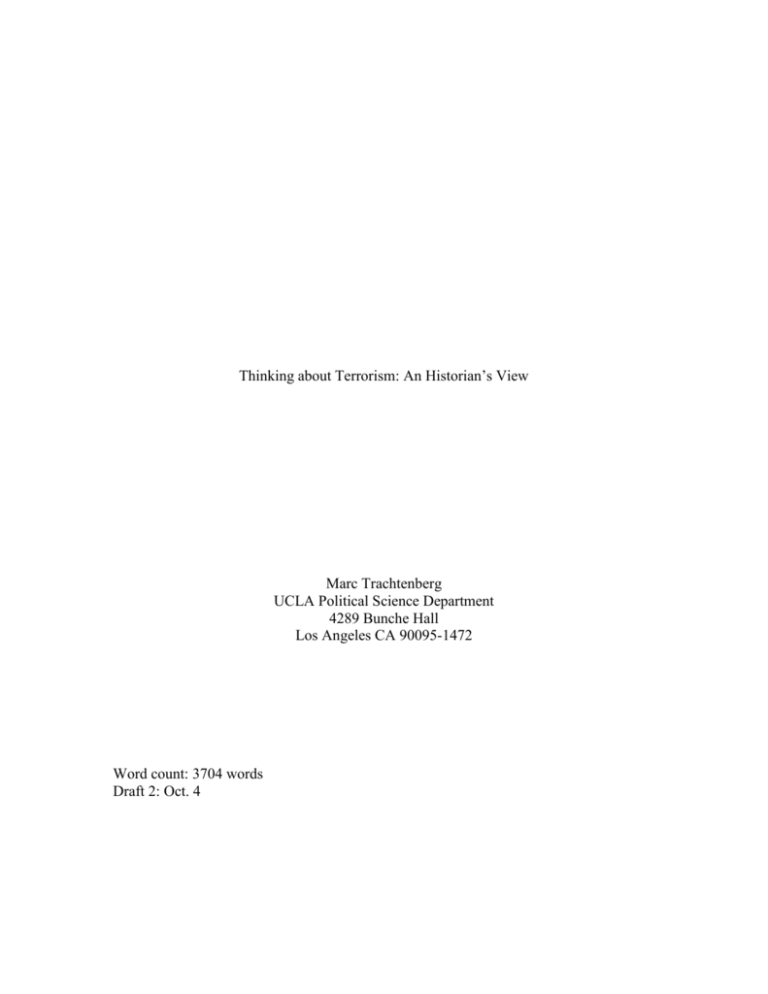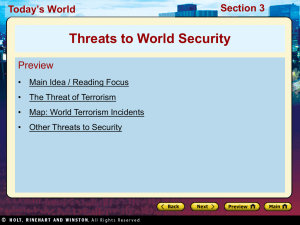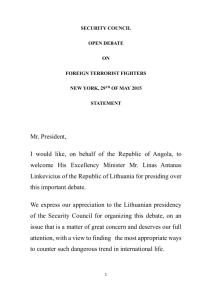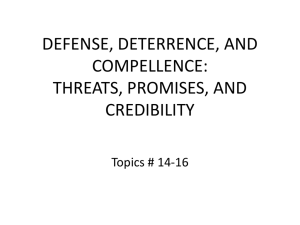Thinking about Terrorism: An Historian`s View
advertisement

Thinking about Terrorism: An Historian’s View Marc Trachtenberg UCLA Political Science Department 4289 Bunche Hall Los Angeles CA 90095-1472 Word count: 3704 words Draft 2: Oct. 4 1 The events of September 11, 2001 were of profound importance mainly because of what those attacks seemed to portend. People almost immediately had the sense that America, and indeed the world as a whole, was entering into a frightening new world. The lesson of the attacks was hard to ignore. There was no limit, it seemed, to what the terrorists who target America were prepared to do. The threat of “biological, chemical, and nuclear terrorism”—of “barbarism emboldened by technology,” as then-candidate George W. Bush called it in his Citadel speech of September 1999—was no longer just a theoretical possibility of interest mainly to academic specialists and to experts in obscure branches of the federal bureaucracy.1 One could now actually imagine hundreds of thousands, even millions of people, dying in a terrorist attack. As Deputy Secretary of Defense Paul Wolfowitz pointed out after the September 11 catastrophe, the “working assumption” had to be “that we could see things much worse than the unimaginable things” the world saw on that day.2 How will this problem be dealt with? People are now thinking mainly in terms of a two-tier strategy. The first tier has to do with what the Bush administration likes to call “homeland defense.” Border controls are to be tightened, and the state is to be granted somewhat greater authority to track down members of terrorist groups and those who support them. But there will be limits to what will be done in this area. The United States sees itself as an open society—open internally, and open to the world. There is at present a real reluctance to tighten up and adopt very strong controls. That reluctance is reflected in the common argument that a real tightening of control is exactly what the terrorists want, and that they would “win” if the United States went that route. That claim is rather dubious, since the openness of American society greatly facilitates terrorist 2 operations; but the frequency with which that argument is made is a measure of where American society is at this point. Whether those attitudes will persist if the problem gets worse is, however, very much open to question. In such a case, it is quite likely that the ideals and norms that still limit what will be done will be swept away; the interest in survival will come to dominate all other concerns. Purely defensive efforts—measures taken in the name of “homeland defense”— will, for the time being at least, not be enough in themselves to neutralize the threat. It is largely because this is so widely understood that the American government, and the country as a whole, now overwhelmingly supports the idea that whatever is done at home needs to be supplemented by an active and multifaceted campaign mounted abroad. That campaign will not be purely reactive in nature. American forces and agents and those governments outside the United States that take part in this effort will try to hunt down and destroy terrorist groups before they can attack. “When you see a rattlesnake poised to strike,” President Roosevelt told the nation sixty years to the day before the September 11 attacks, “you do not wait until he has struck before you crush him.”3 Such notions come to mind quickly, even for leaders of democracies committed to the rule of law, when the threat is great enough. But even sustained offensive action, even a prolonged twilight war in which all legal niceties are pushed to the side, may have only limited effect. Terrorist groups can melt into civilian populations, significant elements of which may view their activities with a certain degree of sympathy; intelligence, crucial in such an anti-terrorist effort, may be difficult to gather; governments outside the United States might, for a variety of reasons, be unable or unwilling to cooperate fully. 3 So suppose the two-tier strategy turns out to be inadequate. Suppose homeland defense measures are of limited effectiveness and active measures are incapable of fully neutralizing the threat at its source. Suppose also that the problem actually worsens— that the United States, and indeed other countries as well, are attacked with chemical, biological, or perhaps even nuclear weapons. Is it to be expected in such a case that America will simply accept the fact that its ability to deal with the threat is limited, and that it will simply have to learn to live with whatever level of devastation terrorist groups are able to inflict? If a fully effective direct defense is beyond reach, if active military and other measures are not able to neutralize an enemy’s ability to launch a devastating attack, is there any additional layer of strategy that could in theory be adopted? With the coming of the nuclear age, the United States had to face the same sort of problem. Continental defense—first air defense against bombers and then defense against incoming missiles— would never, it was understood, be leakproof. It was also clear very early on that sooner or later a preemptive attack, no matter how massive, would not be able to completely wipe out the enemy’s nuclear forces before they launched an attack. Given the enormous power of thermonuclear weapons, enough of them would survive such an attack, be launched, and then get through whatever defensive shield the United States was able to deploy, to utterly destroy America as a functioning society. It was understood almost immediately that what this meant was that there was no alternative to a strategy of deterrence—that is, to a strategy based on the threat of large-scale retaliation. Deterrence theorists, people like Bernard Brodie and above all Thomas Schelling, understood that it was the “power to hurt”—that is, the power to hurt civilians, and indeed civilians who 4 were viewed not just as politically innocent, but as victims of the regime one sought to deter—that now lay at the heart of strategy.4 Terrorism is also based on the “power to hurt.” Will the United States be led, if all else fails, to respond in kind and adopt a strategy of punishing not just terrorists but those who support and protect them? Schelling understood that strategies based on the “power to hurt” were repellent. But given the essence of the problem, he felt it was irresponsible to turn away from the very idea of a strategy of “deliberate, measured violence that carries the threat of more.” Coercion, he thought, was the “business of war,” and one could not shut one’s eyes to the fact that coercion meant exploiting the “power to hurt.”5 The United States today, in dealing with the terrorist threat, may indeed find such strategies repellent, but it is important to realize that U.S. strategy may well move in that direction more rapidly than people now think. In competitive systems, a tactic which gives one side an advantage is not likely for long to remain only that side’s prerogative. 6 As norms are broken down, the constraints on everyone’s behavior are almost bound to dissolve; if all else fails, and if a threat is serious enough, countries will opt for whatever strategy promises to be effective. In such circumstances constraints erode far more rapidly than people realize. In the late 1930s, for example, Americans looked with horror at the bombing of civilians in Spain and in China, but just a few years later they opted for a policy of strategic bombardment with few if any qualms. States, it is often said, seek above all to ensure their own survival.7 The point as it is commonly stated generally does not carry much emotive weight. The assumption is treated essentially as “a radical simplification made for the sake of constructing a 5 theory.”8 But in reality the instinct for self-preservation is extraordinarily strong. When it comes into play, other considerations tend to get swept aside. Again, America’s experience with nuclear weapons is very revealing in this regard. In March 1954, the U.S. National Security Council considered the question of “United States Objectives in the Event of General War with the Soviet Bloc.” Two members of the Joint Chiefs of Staff, Admiral Carney, the Chief of Naval Operations, and General Ridgway, the Army Chief of Staff, felt that the need to consider what the postwar world would be like meant that America would have to conduct a war with the Soviet Union in a relatively limited way. They were afraid that “full exploitation of our nuclear capability might inflict such chaos and destruction and suffering in the Soviet Union as had not been known in Europe since the end of the Thirty Years War.” “Indeed,” given the then-current strategy of all-out attack, “it was impossible” in their view “to visualize how the United States could cope with the victory it might achieve over the Soviets, or how it might hope to establish a workable occupational regime.” President Eisenhower responded by laying out his own basic thinking on the subject with extraordinary vigor and passion. “Everything in any future war with the Soviet bloc,” he insisted, “would have to be subordinated to winning that war.” Nothing else in his view really needed to be said about war objectives. The paragraph in the document being discussed had said that America’s goal was “to achieve a victory which will ensure the survival of the United States as a free nation and the continuation of its free institutions in the post-war period.” Eisenhower would change this “by putting a period after ‘victory’ and deleting the rest of the paragraph, if not the rest of the paper.” “Obviously,” he said, “we were desperately anxious to maintain our free institutions, and 6 we were anxious to help our friends and allies abroad, but we were in no position to count on it or plan on it, in view of the catastrophic nature of the third would war if it should come. In such a war the United States would be applying a force so terrible that one simply could not be meticulous as to the methods by which the force was brought to bear.” Survival was the goal, but for Eisenhower this did not mean America’s survival with its institutions intact. It meant sheer physical survival. He in fact doubted “whether any nations as we now know them would continue to exist” at the end of such a war; “every single nation, including the United States, which entered into this war as a free nation would come out of it as a dictatorship.” But this, he thought, “would be the price of survival.”9 Self-preservation is an absolutely fundamental goal for any society: when it is a question of survival, the norms that might otherwise constrain political action tend to erode quickly. If the problem of terrorism is not resolved, and if matters go from bad to worse, the problem may well come to be defined in such primordial terms; if that happens, the element of deterrence is bound to loom larger in American strategy. There are some indications that policy is already beginning to shift in that direction. When candidate Bush, in his Citadel speech, alluded to the “threat of biological, chemical and nuclear terrorism,” he pointed out that a terrorist attack did not require ballistic missiles. The weapons, he said, could be delivered by everything from airplanes to shipping containers to suitcases. And he issued a warning: “every group or nation must know, if they sponsor such attacks, our response will be devastating.”10 That passage in the Citadel speech was recalled by Secretary of Defense Donald Rumsfeld in an interview he gave twelve days after the September 11 attacks. He was responding to a 7 question about whether the United States had “ruled out the use of nuclear weapons” in connection with the anti-terrorist campaign.11 A week earlier, on another one of the Sunday morning public affairs programs, Sam Donaldson had asked him the same question: Donaldson: Can we rule out the use of nuclear weapons? Rumsfeld: You know, that subject—we have an amazing accomplishment that has been achieved on the part of human beings. We have had this unbelievably powerful weapon, nuclear weapon, since, what?—55 years now, plus—and it's not been fired in anger since 1945. That's an amazing accomplishment. I think it reflects a sensitivity on the part of successive presidents that they ought to find as many other ways to deal with problems as is possible. Donaldson: I'll have to think about your answer. I don't think the answer was no. Rumsfeld: The answer was that we ought to be very proud of the record of humanity, that we have not used those weapons for 55 years. And we have to find as many ways possible to deal with this serious problem of terrorism. And if, Sam, you think of the loss of human life on Tuesday, and then put in your head the reality that a number of countries today have other so-called asymmetrical threat capabilities—ballistic missiles, cruise missiles, chemical weapons, biological weapons, cyber warfare—these are the kinds of things that are used in this era of the 21st century. And a germ warfare attack anywhere in 8 the world would bring about losses of lives not in the thousands but in the millions.12 The Secretary of Defense did not quite come out and say it, but the implication was that the threat was extremely serious, and if it could not be dealt with in lesser ways, a more extreme retaliatory policy could not be ruled out. A third tier of strategy is thus beginning to take shape: an element of deterrence is being built into American policy. One has the sense today of standing on the edge of an abyss, and of staring down into a hellish world. If the United States is attacked with biological agents and hundreds of thousands of people die, then the response is going to be ferocious. People will say that we owe it to future generations to put an end to the problem by whatever means are necessary—that when terrorists strike, it has to be made clear to the populations and governments that harbor or even just tolerate those groups that the cost of doing so will be unbearable. As in the case of Cold War nuclear strategy, moral constraints will count for little. With physical survival on the line, America will sooner or later opt for whatever strategy promises to be effective. One can scarcely imagine what the world would be like it things degenerated to the point where such strategies were actually put into effect—or indeed what it would be like to live in a world where large-scale terrorist attacks became common and were not effectively deterred. But if things are to be kept from degenerating to that level, it is of vital importance to bear in mind what might well happen if the problem of terrorism is not brought under control. A sense for the horrors that a failure in this area would unleash—not just the horrors America would suffer, but also the horrors America might 9 inflict—is essential if such a situation is to be avoided. To understand the risk that the situation might develop along these lines is therefore to understand the extraordinary importance of solving the problem in far more acceptable ways—that is, of making sure that the three-tier policy now taking shape is as effective as possible. And this point holds not just for Americans but for people throughout the world, and especially for people in the Middle East. With regard to the first two tiers of policy—“homeland defense” and energetic action to root out and destroy terrorist networks capable of launching attacks of the sort we saw on September 11, or worse—relatively little needs to be said. Every effort has to be made to assure the success of those efforts, not least because of the need to reduce America’s reliance on a strategy of deterrence, with all its possibly appalling effects. But with regard to the deterrent component of the strategy, and to its relation to the two other tiers of the strategy, a number of comments are in order. Here again we need to draw on insights that emerged as people grappled with the nuclear problem during the Cold War. A deterrent strategy is fundamentally different from a strategy that focuses on what a target group is able to do. The aim instead is to influence that group’s thinking; the goal is to generate a sense for the risks that that group would be running if it adopted, or persisted in, a certain course of action. What one actually did was not of fundamental importance in itself; the objective was to generate a certain sense for what might happen further down the road. A threat is made not because one actually wants to execute it. Indeed—to oversimplify the problem somewhat for the sake of making the point—the deterrent strategy would have failed if the threat had to be executed.13 10 In working out a deterrent strategy in detail, considerable emphasis thus has to be placed on the thinking of the target group—on what it believes the would-be deterrer would do if it acted in certain ways, and especially on the sorts of things that would make the threat credible in its eyes. And what matters here is the whole picture that takes shape in the eyes of the various target groups whose behavior the deterrer wants to influence— in the case we are dealing with here, not just members of terrorist organizations themselves, but even more the governments and societies that support and protect them. Simple declarations of policy in themselves will have only limited effect. What really matters is the broad political behavior of the deterrer’s society and government as a whole; in this case, what really matters is the depth and intensity of America’s commitment as a society to dealing with the problem. That commitment is reflected, first of all, in the way Americans as a nation talk about the problem. The mere fact that the current campaign is being called a war, not just by the American government, but by the nation as a whole—and quite spontaneously at that—sends a powerful signal. Once something is defined as a war, a theory of collective responsibility almost automatically replaces a theory of individual responsibility as the basis for political action. In talking about these issues, the effect is greatest when the tone is somber, serious and resolute—when the element of deterrence is alluded to in a regretful way, as an inescapable consequence of a failure to bring the problem under control in more conventional ways. That effect can be achieved in many ways; one basic technique, familiar from Cold War nuclear strategy, is the ruling out of alternatives: “it is inconceivable, if the United States is forced to respond to an attack with biological 11 weapons that causes the death of tens of thousands of Americans, that our response will be measured and moderate.” The way the problem is discussed is very important, but the sort of image that is projected—the sense the country gives of the intensity of its resolve as a nation—is also measured by what is actually done. America’s willingness to make real sacrifices, both at home and abroad, is a fundamental indicator of the seriousness with which it takes the problem—and of its willingness, in the final analysis, if it feels it has no alternative, to resort to more extreme courses of action. The three tiers of strategy are thus tightly interconnected. Vigorous policies of homeland defense and of rooting out terrorist networks abroad would, if successful, reduce the need to resort to a deterrent strategy; their success would reduce the burden that the deterrent strategy would have to carry. But by the same token, if the first two tiers of strategy are relatively ineffective, then greater dependence would have to be placed on a strategy of deterrence. And knowing that—seeing what the consequences would be of failure in those first two areas—people both at home and abroad would come to understand better the importance of succeeding in those areas, and would thus act in such a way as to bring success more within reach. And the way Americans conduct themselves in the area of homeland defense and in the anti-terrorist campaign abroad will also help shape people’s sense for the credibility of the deterrence component of the strategy, and will thus help determine its effectiveness. To think in terms of deterrence is to think in terms of what will influence the behavior not so much of the terrorist groups themselves, but of those governments and societies that harbor them and share their hatred of the United States. Nations of that sort 12 have to strike a balance. They have to weigh the attractiveness of a policy of inflicting pain on American society against the risks that they themselves would be running. The goal of a strategy of deterrence would be to affect the way they strike that balance. In dealing with the problem of terrorism, it is of course important for Americans to consider the political side of the problem—to try to understand why anti-American feelings run so deep in the Islamic world in general, and especially in the Arab world—and to rethink their own political behavior in that light. The Arab-Israeli problem is obviously of central importance in this regard; the more general issue of America’s role in the Middle East also relates in a very fundamental way to this whole complex of issues. But as important as these issues are, it is essential to realize that there is also a major strategic dimension to the problem, and that that question of strategy is analytically distinct and can be examined on its own terms. And indeed it has to be examined on its own terms if the strategic problem is to be brought into focus. The problem of terrorism—that is, the strategic side of that problem—has to be taken with the utmost seriousness, and the sooner we face up to it, the better off the whole world will be. 13 NOTES 1 The text of this widely-noted speech is available can be found, for example, at http://www.ransac.org/new-web-site/related/govt/testimony/bush-092399.html 2 “Deputy Secretary Wolfowitz Interview with NPR All Things Considered,” September 14, 2001, http://www.defenselink.mil/cgi-bin/dlprint.cgi 3 This was his justification for the famous “shoot on sight” order issued to American naval forces in the Atlantic following the Greer incident a week earlier. For an extract from the speech containing this quotation, see Robert Dallek, Franklin D. Roosevelt and American Foreign Policy, 1932-1945 (Oxford: Oxford University Press, 1979), p. 288. 4 See especially Thomas Schelling, Arms and Influence (New Haven: Yale University Press, 1966), pp. v, 2, 7. 5 Ibid., pp. 201-203, 215-216. 6 This is one of the most important arguments developed in Kenneth Waltz, Theory of International Politics (New York: McGraw Hill, 1979), esp. pp. 127-128. 7 That assumption of course lies at the heart of the neorealist theory of international politics. See especially Waltz, Theory of International Politics, p. 91. 8 Ibid., p. 91. 9 Summary of Discussion of the 190th meeting of the National Security Council, March 25, 1954, Eisenhower Presidential Papers (Ann Whitman File), NSC Series, box 5, Dwight D. Eisenhower Library, Abilene, Kansas. 10 The source is given in n. 1 above. 11 “Secretary Rumsfeld on CBS ‘Face the Nation,’” September 23, 2001, http://www.defenselink.mil/news/Sep2001/t09232001_t0923sd.html 12 “Secretary Rumsfeld Interview for ABC News This Week,” September 16, 2001, http://www.defenselink.mil/news/Sep2001/t09162001_t0916sd.html 13 What complicates the problem is that the threat may have to be brought home only by some act or campaign of violence: “unhappily,” as Schelling pointed out, “the power to hurt is often communicated by 14 some performance of it.” Arms and Influence, p. 3. Brodie interpreted the atomic bombardment of Japan in similar terms. It was not, he thought, the bombs dropped on Hiroshima and Nagasaki that led the Japanese to surrender, but rather the “threat of more to come,” the threat posed by the “nonexistent additional bombs which the Japanese didn’t know we didn’t have.” Bernard Brodie, “Changing Capabilities and War Objectives,” lecture given at the Air War College, April 17, 1952, Bernard Brodie Papers, box 12, UCLA Library, Los Angeles, California.








